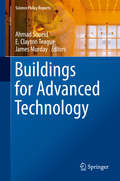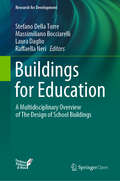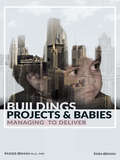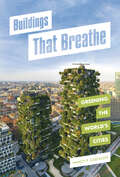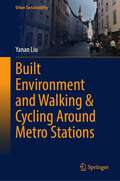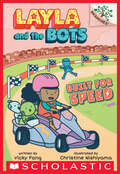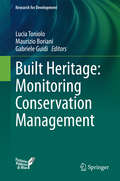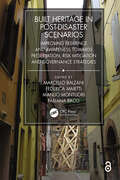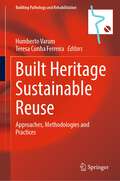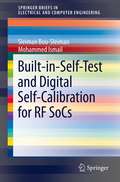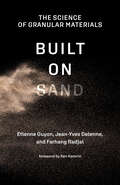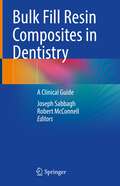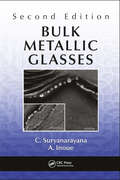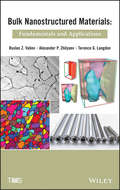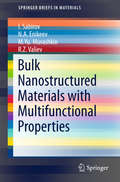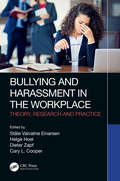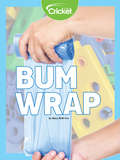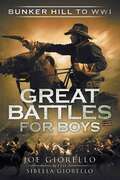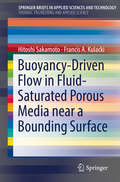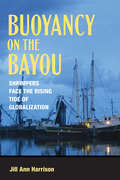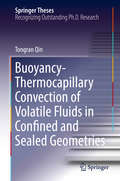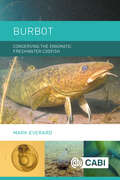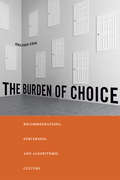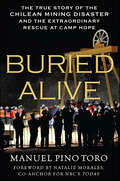- Table View
- List View
Buildings for Advanced Technology (Science Policy Reports)
by Ahmad Soueid E. Clayton Teague James MurdayThis book deals with the design and construction of buildings for nanoscale science and engineering research. The information provided in this book is useful for designing and constructing buildings for such advanced technologies as nanotechnology, nanoelectronics and biotechnology. The book outlines the technology challenges unique to each of the building environmental challenges outlined below and provides best practices and examples of engineering approaches to address them: * Establishing and maintaining critical environments: temperature, humidity, and pressure * Structural vibration isolation * Airborne vibration isolation (acoustic noise) * Isolation of mechanical equipment-generated vibration/acoustic noise * Cost-effective power conditioning * Grounding facilities for low electrical interference * Electromagnetic interference (EMI)/Radio frequency interference (RFI) isolation * Airborne particulate contamination * Airborne organic and chemical contamination * Environment, safety and health (ESH) considerations * Flexibility strategies for nanotechnology facilities The authors are specialists and experts with knowledge and experience in the control of environmental disturbances to buildings and experimental apparatus.
Buildings for Education: A Multidisciplinary Overview of The Design of School Buildings (Research for Development)
by Stefano Della Torre Massimiliano Bocciarelli Laura Daglio Raffaella NeriThis open access book presents theoretical and practical research relating to the vast, publicly financed program for the construction of new schools and the reorganization of existing educational buildings in Italy. This transformative process aims to give old buildings a fresh identity, to ensure that facilities are compliant with the new educational and teaching models, and to improve both energy efficiency and structural safety with respect to seismic activity. The book is divided into three sections, the first of which focuses on the social role of the school as a civic building that can serve the needs of the community. Innovations in both design and construction processes are then analyzed, paying special attention to the Building Information Modeling (BIM) strategy as a tool for the integration of different disciplines. The final section is devoted to the built heritage and tools, technologies, and approaches for the upgrading of existing buildings so that they meet the new regulations on building performance. The book will be of interest to all who wish to learn about the latest insights into the challenges posed by, and the opportunities afforded by, a comprehensive school building and renovation program.
Buildings, Projects, and Babies: Managing to Deliver
by Yara Osman Yasser OsmanOffering tips and strategies in this manual for project managers, The Author -An experienced project manager- who has worked on many construction sites, never uses the word “problem” for the hurdles that come up during the building process. He prefers the term “issues,” because to call something a problem is to expect no solution, and a project manager has no such luxury. Balancing between the Moving Wealth (Team) and Fixed Wealth (Thing), this book, seeks to explain the role of the project manager and to offer strategies for those who fill that role. The Book has a favourite metaphor for his field: “the construction site itself can be seen as a kind of ‘delivery room.’ ” The building’s architect is the doctor; the client is the father; the contractor is the mother. The project manager, whose responsibilities are the focus of the book, is the equivalent of the delivery room nurse “in their ability to monitor events, and to identify issues that require immediate solutions, find those solutions, and implement them.” The Book runs through a series of situations in which various construction-related problems arise and walks the reader through the ways to fix them. By keeping a cool head and falling back on fundamentals like foresight, planning, and creative thinking, a manager can always keep the project on schedule and on budget. The book is written specifically for project managers working in the construction industry, but the fundamental managerial skills are applicable in any situation that involves a large team and accountability to a third party. This book is trying to reflect a quick, comprehensive guide to successful project management.
Buildings That Breathe: Greening the World's Cities
by Nancy F. CastaldoImagine looking out from your 18th floor apartment in the middle of the city and seeing trees right in front of you. In an effort to stem climate change, reduce pollution, combat heat, and protect biodiversity, architects are teaming up with botanists, urban wildlife ecologists, and other scientists to design high-rise forests, living walls, and vertical farms in some of the world’s most populated places. These projects are happening all around the world, and they will not only change the urban landscape, but they will provide urban dwellers with a healthier place to live and work. For Buildings That Breathe, author and environmental journalist Nancy Castaldo connected with architect Stefano Boeri at the World Forum on Urban Forests and was invited to his office in Milan where she visited Bosco Verticale, the first high-rise forest. Planted with 750 trees, 5,000 shrubs, and 11 perennials on two apartment towers, the project provides an urban habitat for birds, insects, and people while creating a micro-climate that produces oxygen and provides shade for high-rise residents. Explore Bosco Verticale, as well the planned Liuzhou Forest City in China and other green architecture projects around the world, looking at how people are working together to change the urban landscape of the future.
Built Environment and Walking & Cycling Around Metro Stations (Urban Sustainability)
by Yanan LiuThis book explores the relationship between pedestrians/cyclists’ mode and route choice to/from metro/railway stations and the micro-level (street-scale) built environment in a second-tier city in China. More specifically, it investigates how the street-scale built environment influences pedestrians/cyclists’ mode choice and route choice behavior and examines user preferences for the micro-level built environment around metro stations. The focus on a second-tier city is motivated primarily to expand the set of Chinese cities where the effects of the built environment on pedestrian/cyclist mode and route choice have been studied. Results demonstrate the effects of the street-scale built environment on pedestrian flows. The effects are higher for the main road, which is directly connected with the metro station. The findings of this book are expected to support the design of preferred walking/biking built environments around a metro station. This book appeals to urbanists, planners, engineers, policy makers, and those interested in a wide-ranging overview of slow/green transportation and built environment promotion. These methods not only help to understand the quantitative relationship between built environment design and travel behavior but also support the evaluation and assessment of built environment design in urban planning projects. It reduces the gap in our understanding of the quantitative relationship between the micro-level built environment and pedestrians/cyclists’ transportation mode and route choice around the metro station. Both stated choice data and revealed choice data were used. An extended set of micro-level built environment attributes was developed. Besides the widely studied transportation-related factors, street-level built environment factors were studied using quantitative methods.
Built for Speed: A Branches Book (Layla and the Bots #2)
by Vicky FangReady, set, go! Layla and the Bots are heading to the races!Pick a book. Grow a Reader!This series is part of Scholastic's early chapter book line Branches, aimed at newly independent readers. With easy-to-read text, high-interest content, fast-paced plots, and illustrations on every page, these books will boost reading confidence and stamina. Branches books help readers grow!Blossom Valley is hosting a go-kart race! The go-karts are provided for all the kids in town. Layla and the Bots can't wait for race day! But one racer, Tina, needs their help. She needs a new cart that uses hand-controls and other cool features. Layla and the Bots know just what to do... they will build her a brand-new cart that's even faster than her wheelchair! But will Tina's go-kart have enough speed to win the race? With full-color artwork on every page and speech bubbles throughout, this early chapter book series brings kid-friendly STEAM topics to young readers!
Built Heritage: Monitoring Conservation Management (Research for Development)
by Lucia Toniolo Maurizio Boriani Gabriele GuidiThis book provides a comprehensive, up-to-date overview on the most pressing issues in the conservation and management of archaeological, architectural, and urban landscapes. Multidisciplinary research is presented on a wide range of built heritage sites, from archaeological ruins and historic centers through to twentieth century and industrial architectural heritage. The role of ICT and new technologies, including those used for digital archiving, surveying, modeling, and monitoring, is extensively discussed, in recognition of their importance for professionals working in the field. Detailed attention is also paid to materials and treatments employed in preventive conservation and management. With contributions from leading experts, including university researchers, professionals, and policy makers, the book will be invaluable for all who seek to understand, and solve, the challenges face d in the protection and enhancement of the built heritage.
Built Heritage in post-Disaster Scenarios: Improving Resilience and Awareness Towards Preservation, Risk Mitigation and Governance Strategies
by Marcello BalzaniIt is assumed that the impact of natural and man-made hazards on society in terms of damage cannot be avoided. To reduce potential disaster levels and to assess which policies have had a positive outcome, a careful comparison should take place on the procedures implemented in the management of crises.The experiences with the earthquakes in the Pianura Padana area and central regions of Italy in the last ten years have been incorporated in the 'After the Damages' advanced training project. This project aims to showcase recent innovations and advancements in post-disaster management, so as to take a more proactive role in post-disaster management, and to respond more effectively when disasters occur.This volume provides insights into the dynamics and negative effects of natural and man-made hazards (i.e., earthquakes, fires, floods, droughts, volcanic eruptions, etc.), including more updated approaches to deal with post-disaster phases. The book also offers tools to deal with possible international crisis scenarios and mitigate the social impact of vulnerabilities through risk reduction.Built Heritage in post-Disaster Scenarios aims at public administration managers, government agency representatives, international organizations, researchers, and professionals in architecture, engineering, and earth science.Marcello Balzani, Architect, PhD in "Representation and Survey", Full Professor of Representation at the Department of Architecture, University of Ferrara. President of Clust-ER Building and Construction. He is author of more than 200 publications on the themes of Drawing and Architectural and Urban Surveying, Project Representation, Management and Visualisation.Federica Maietti, Architect, PhD, Associate Professor in the Scientific Sector ICAR/17 at the Department of Architecture, University of Ferrara. Member of the DIAPReM Centre, since 2005 she carries out research activities in the fields of heritage documentation, survey and diagnostic investigations, in different national and international contexts, including Pompeii, Malta, Brazil, India, and Mexico. Scientific Manager of the International Academy "After the Damages", she is involved in several research activities and she is the author of more than two hundred publications in the field of Heritage Documentation, Survey and Representation.Manlio Montuori, Architect, PhD, former assistant professor non-tenured at the University of Ferrara, Department of Architecture, where he is a member of the Labo.R.A. The main field of his research is the conservation of architectural heritage and landscape, with special emphasis on preservation procedures for traditional and industrial built heritage. His research interests also address assessment and management in the context of damage and disaster risk reduction. Scientific Manager of the International Academy "After the Damages", he is involved in several research projects implementing ICT technologies in the conservation and structural health assessment of built and cultural heritage.Fabiana Raco, Architect, PhD RTDa Researcher of Drawing at the Department of Architecture, University of Ferrara. Technical coordinator of TekneHub Laboratory. Author of more than 50 publications on the topics of Drawing, Architectural and Urban Surveying, Representation, Diagnostics, Visualization and Project Management of interventions on built heritage.
Built Heritage Sustainable Reuse: Approaches, Methodologies and Practices (Building Pathology and Rehabilitation #26)
by Humberto Varum Teresa Cunha FerreiraThis book gathers the latest advances and innovations in the field of sustainable reuse of built heritage, as presented by international researchers at the conference "ReUSO - Documentation, Restoration and Reuse of Heritage”, held on November 2-4, 2022, at the Faculty of Engineering of the University of Porto (FEUP), Porto, Portugal. The X edition of the ReUSO conference promoted the discussion among the participants on issues related to the sustainable and adaptive reuse of built heritage, from the theoretical perspectives to the methodological and practical applications in contemporary interventions in relation to the complexity and vulnerability of the present-day context and the future orientations of our scientific sectors.
Built-in-Self-Test and Digital Self-Calibration for RF SoCs (SpringerBriefs in Electrical and Computer Engineering)
by Mohammed Ismail Sleiman Bou-SleimanThis book will introduce design methodologies, known as Built-in-Self-Test (BiST) and Built-in-Self-Calibration (BiSC), which enhance the robustness of radio frequency (RF) and millimeter wave (mmWave) integrated circuits (ICs). These circuits are used in current and emerging communication, computing, multimedia and biomedical products and microchips. The design methodologies presented will result in enhancing the yield (percentage of working chips in a high volume run) of RF and mmWave ICs which will enable successful manufacturing of such microchips in high volume.
Built on Sand: The Science of Granular Materials
by Etienne Guyon Jean-Yves Delenne Farhang RadjaiExplaining the science contained in a simple assembly of grains—the most abundant form of matter present on Earth.Granular media—composed of vast amounts of grains, consolidated or not—constitute the most abundant form of solid matter on Earth. Granular materials assemble in disordered configurations scientists often liken to a bag of marbles. Made of macroscopic particles rather than molecules, they defy the standard scheme of classification in terms of solid, liquid, and gas. Granular materials provide a model relevant to various domains of research, including engineering, physics, and biology. William Blake famously wished “To See a World in a Grain of Sand”; in this book, pioneering researchers in granular matter explain the science hidden behind simple grains, shedding light on collective behavior in disordered settings in general.The authors begin by describing the single grain with its different origins, shapes, and sizes, then examine grains in piled or stacked form. They explain the packing fraction of granular media, a crucial issue that bears on the properties displayed in practical applications; explore small-scale deformations in piles of disordered grains, with particular attention to friction; and present theories of various modes of disorder. Along the way, they discuss such concepts as force chains, arching effects, wet grains, sticky contacts, and inertial effects. Drawing on recent numerical simulations as well as classical concepts developed in physics and mechanics, the book offers an accessible introduction to a rapidly developing field.
Bulk Fill Resin Composites in Dentistry: A Clinical Guide
by Joseph Sabbagh Robert McConnellThis book is dedicated to all relevant aspects of bulk fill materials and their uses in clinical practice. Today, we count over 30 different bulk fill materials, which can be used in the dental clinic. The composition of bulk fill materials and their different modes of application for moderate to large direct resin restorations placement are explained in this book. It is written by a group of international specialists and allows the reader to evaluate available materials, learn predictable techniques and evaluate long term survival as well as future developments. The book covers all fields related to the history of bulk fill composites, their composition and physical properties, and a step by step guide to their successful clinical applications. Practitioners will find it invaluable as a clinical manual and a good reference book.
Bulk Metallic Glasses: 2002 Mrs Fall Meeting, Boston, Ma (Mrs Proceedings Ser. #754)
by C. Suryanarayana A. InoueReflecting the fast pace of research in the field, the Second Edition of Bulk Metallic Glasses has been thoroughly updated and remains essential reading on the subject. It incorporates major advances in glass forming ability, corrosion behavior, and mechanical properties. Several of the newly proposed criteria to predict the glass-forming ability of alloys have been discussed. All other areas covered in this book have been updated, with special emphasis on topics where significant advances have occurred. <P><P> These include processing of hierarchical surface structures and synthesis of nanophase composites using the chemical behavior of bulk metallic glasses and the development of novel bulk metallic glasses with high-strength and high-ductility and superelastic behavior. New topics such as high-entropy bulk metallic glasses, nanoporous alloys, novel nanocrystalline alloys, and soft magnetic glassy alloys with high saturation magnetization have also been discussed. Novel applications, such as metallic glassy screw bolts, surface coatings, hyperthermia glasses, ultra-thin mirrors and pressure sensors, mobile phone casing, and degradable biomedical materials, are described. Authored by the world’s foremost experts on bulk metallic glasses, this new edition endures as an indispensable reference and continues to be a one-stop resource on all aspects of bulk metallic glasses.
Bulk Nanostructured Materials
by Terence G. Langdon Alexander P. Zhilyaev Ruslan Z. ValievThis book presents the most recent results in the area of bulk nanostructured materials and new trends in their severe plastic deformation (SPD) processing, where these techniques are now emerging from the domain of laboratory-scale research into the commercial production of various bulk nanomaterials. Special emphasis is placed on an analysis of the effect of nanostructures in materials fabricated by SPD on mechanical properties (strength and ductility, fatigue strength and life, superplasticity) and functional behavior (shape memory effects, magnetic and electric properties), as well as the numerous examples of their innovative applications. There is a high innovation potential for industrial applications of bulk nanomaterials for structural use (materials with extreme strength) as well as for functional applications such as nanomagnets, materials for hydrogen storage, thermoelectric materials, superconductors, catalysts, and biomedical implants.
Bulk Nanostructured Materials with Multifunctional Properties (SpringerBriefs in Materials)
by I. Sabirov N. A. Enikeev M. Yu. Murashkin R. Z. ValievThis book presents a multifunctional approach to the design of bulk nanostructured metals through severe plastic deformation (SPD). Materials engineering has traditionally involved selecting a suitable material for a given application. However, modern engineering frequently requires materials with a set of multifunctional, often conflicting properties: Enhanced mechanical properties need to be combined with improved physical (electrical, magnetic, etc. ) and/or chemical (corrosion resistance, biocompatibility) properties. So disparate materials properties need to be engineered and optimized simultaneously. These requirements have created a paradigm shift in which the classical materials selection approach is replaced by design of material microstructures to achieve certain performance requirements, subject to constraints on individual properties such as strength, conductivity, and corrosion resistance. Written by researchers at the forefront of this new materials design approach, the present volume provides a comprehensive introduction to multifunctional design of bulk nanostructured materials, with applications ranging from hydrogen storage to construction engineering.
Bullying and Harassment in the Workplace: Theory, Research and Practice
by Ståle Valvatne Einarsen Helge Hoel Dieter Zapf Cary L. CooperBuilding on the success of two earlier best-selling editions from 2003 and 2011, this benchmark text and highly cited reference work now appears in its third edition. This book is a research-based resource on key aspects of workplace bullying and its remediation, which: Covers the nature and complexities of bullying and harassment in the workplace Presents the evidence on its prevalence, risk groups, antecedents and outcomes Examines cyberbullying and harassment in the digital world Describes the roles of bystanders and the coping possibilities of victims Discusses prevention, intervention, treatment and the management of specific cases Explains legal perspectives, the role of HR and of internal policies Edited by leading experts in the field and presenting contributions from subject experts, it provides state-of-the-art reviews of the main themes in the field, as well as practical remedies and solutions at individual, organizational and societal levels, providing a much-needed update and expansion of the original work, as the research and literature on this problem with its manifold detrimental effects has expanded radically over the last decade. This book should be of interest to all scholars in the field of organizational behavior and social processes at work. In particular, the book is a much-needed tool for bachelor, master and PhD students, new and experienced researchers in the field, advanced practitioners and policy makers, including labor inspectors, union representatives, HR-personnel, lawyers, management consultants, and counsellors in private practice, family physicians and occupational health practitioners, to name a few.
Bum Wrap
by Mary Beth CoxPlastic was once considered the material of the future, but now it has become a nuisance that results in too much trash for the planet to handle. Learn about the durability and longevity of this 19th-century invention and hear recycling ideas from a chemist who hopes to salvage plastic's reputation.
Bunker Hill to WW I (Great Battles for Boys)
by Joe GiorelloIn chronological order, beginning with the Revolutionary War, Great Battles for Boys: Bunker Hill to WWI takes young readers to the front lines of American history's most thrilling clashes. Boys discover the raw truth about the colonial fight for freedom, the hardships of Civil War soldiers, the fierce battle of the Alamo, the American Expeditionary Forces winning World War I, and much more!
Buoyancy-Driven Flow in Fluid-Saturated Porous Media near a Bounding Surface (SpringerBriefs in Applied Sciences and Technology)
by Hitoshi Sakamoto Francis A. KulackiThis Brief reports on heat transfer from a solid boundary in a saturated porous medium. Experiments reveal overall heat transfer laws when the flow along the wall is driven by buoyancy produced by large temperature differences, and mathematical analysis using advanced volume-averaging techniques produce estimates of how heat is dispersed in the porous zone. Engineers, hydrologists and geophysicists will find the results valuable for validation of laboratory and field tests, as well as testing their models of dispersion of heat and mass in saturated media.
Buoyancy Effects on Natural Ventilation
by Torwong ChenvidyakarnThis book describes in depth the fundamental effects of buoyancy, a key force in driving air and transporting heat and pollutants around the interior of a building. This book is essential reading for anyone involved in the design and operation of modern sustainable, energy-efficient buildings, whether a student, researcher or practitioner. The book presents new principles in natural ventilation design and addresses surprising, little-known natural ventilation phenomena that are seldom taught in architecture or engineering schools. Despite its scientific and applied mathematics subject, the book is written in simple language and contains no demanding mathematics, while still covering both qualitative and quantitative aspects of ventilation flow analysis. It is therefore suitable for both non-expert readers who just want to develop intuition of natural ventilation design and control (such as architects and students) and for those possessing more expertise whose work involves quantifying flows (such as engineers and building scientists).
Buoyancy on the Bayou: Shrimpers Face the Rising Tide of Globalization
by Jill Ann HarrisonOver the past several decades, shrimp has transformed from a luxury food to a kitchen staple. While shrimp-loving consumers have benefited from the lower cost of shrimp, domestic shrimp fishers have suffered, particularly in Louisiana. Most of the shrimp that we eat today is imported from shrimp farms in China, Vietnam, and Thailand. The flood of imported shrimp has sent dockside prices plummeting, and rising fuel costs have destroyed the profit margin for shrimp fishing as a domestic industry. In Buoyancy on the Bayou, Jill Ann Harrison portrays the struggles that Louisiana shrimp fishers endure to remain afloat in an industry beset by globalization. Her in-depth interviews with more than fifty individuals working in or associated with shrimp fishing in a small town in Louisiana offer a portrait of shrimp fishers' lives just before the BP oil spill in 2010, which helps us better understand what has happened since the Deepwater Horizon disaster. Harrison shows that shrimp fishers go through a careful calculation of noneconomic costs and benefits as they grapple to figure out what their next move will be. Many willingly forgo opportunities in other industries to fulfill what they perceive as their cultural calling. Others reluctantly leave fishing behind for more lucrative work, but they mourn the loss of a livelihood upon which community and family structures are built. In this gripping account of the struggle to survive amid the waves of globalization, Harrison focuses her analysis at the intersection of livelihood, family, and community and casts a bright light upon the cultural importance of the work that we do.
Buoyancy-Thermocapillary Convection of Volatile Fluids in Confined and Sealed Geometries (Springer Theses)
by Tongran QinThis thesis represents the first systematic description of the two-phase flow problem. Two-phase flows of volatile fluids in confined geometries driven by an applied temperature gradient play an important role in a range of applications, including thermal management, such as heat pipes, thermosyphons, capillary pumped loops and other evaporative cooling devices. Previously, this problem has been addressed using a piecemeal approach that relied heavily on correlations and unproven assumptions, and the science and technology behind heat pipes have barely evolved in recent decades. The model introduced in this thesis, however, presents a comprehensive physically based description of both the liquid and the gas phase. The model has been implemented numerically and successfully validated against the available experimental data, and the numerical results are used to determine the key physical processes that control the heat and mass flow and describe the flow stability. One of the key contributions of this thesis work is the description of the role of noncondensables, such as air, on transport. In particular, it is shown that many of the assumptions used by current engineering models of evaporative cooling devices are based on experiments conducted at atmospheric pressures, and these assumptions break down partially or completely when most of the noncondensables are removed, requiring a new modeling approach presented in the thesis. Moreover, Numerical solutions are used to motivate and justify a simplified analytical description of transport in both the liquid and the gas layer, which can be used to describe flow stability and determine the critical Marangoni number and wavelength describing the onset of the convective pattern. As a result, the results presented in the thesis should be of interest both to engineers working in heat transfer and researchers interested in fluid dynamics and pattern formation.
Burbot: Conserving the Enigmatic Freshwater Codfish
by Mark EverardThe burbot has a unique ecology as the only member of the order of cod-like fishes found in freshwater. It is the second most widely distributed freshwater fish in the Northern Hemisphere, variously threatened, extinct or thriving across different parts of this wide Palaearctic range. Burbot were driven to extinction from Britain most probably in the 1970s, the last recorded specimen caught in 1969 in Cambridgeshire. Particularly over the past decade, a large body of work has addressed potential reintroduction of the burbot to Britain. The burbot's diverse habitat and other needs throughout its life stages also mean that the species is a flagship for a diversity of other wildlife of restored river systems, and of the human benefits that these ecosystems can provide. Burbot is an excellent source for all those involved in freshwater fish and fisheries management, conservation and exploitation, including fish biologists (ichthyologists), environmental scientists, freshwater biologists, fisheries managers and scientists, conservation biologists, engineers and hydrologists. The libraries of all universities and research establishments where these subjects are studied and taught should have a copy. Anglers and all those interested in fishes and natural history will also benefit from this book.
The Burden of Choice: Recommendations, Subversion, and Algorithmic Culture
by Jonathan CohnThe Burden of Choice examines how recommendations for products, media, news, romantic partners, and even cosmetic surgery operations are produced and experienced online. Fundamentally concerned with how the recommendation has come to serve as a form of control that frames a contemporary American as heteronormative, white, and well off, this book asserts that the industries that use these automated recommendations tend to ignore and obscure all other identities in the service of making the type of affluence they are selling appear commonplace. Focusing on the period from the mid-1990s to approximately 2010 (while this technology was still novel), Jonathan Cohn argues that automated recommendations and algorithms are far from natural, neutral, or benevolent. Instead, they shape and are shaped by changing conceptions of gender, sexuality, race, and class. With its cultural studies and humanities-driven methodologies focused on close readings, historical research, and qualitative analysis, The Burden of Choice models a promising avenue for the study of algorithms and culture.
Buried Alive: The True Story of the Chilean Mining Disaster and the Extraordinary Rescue at Camp Hope
by Manuel Pino ToroThe inside story of the thirty-three Chilean miners trapped 2,300 feet underground that captivated the worldOn August 5, 2010, a tunnel in the gold and copper mine in the Atacama Desert in Chile collapsed, with all of its miners trapped underground. For days, the families waited breathlessly as percussion drills searched out signs of life. Finally, a note came back from below--the miners were alive and safe. Now the rescue crew needed to burrow through 2300 feet of solid rock to get them out. For nine weeks, the world watched as Chile threw all of its resources into the effort. Televisions flashed images of worried families holding vigil night and day and of Chile's newly elected President Pinera making their recovery his personal crusade. What the cameras didn't reveal was the behind-the-scenes intrigue: the corruption that led to faulty construction of the tunnel in the first place; how the men lived in a muddy and humid environment where the temperature was unbearably hot; how the rescue effort became a political campaign to raise the president's sagging numbers; and the abundant hope necessary to sustain the men in their underground captivity. Author Manuel Pino takes us into his native Chile and, drawing on direct access to the miners and their families, weaves a rich narrative of extraordinary survival and triumph.
